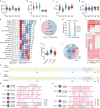A super pan-genomic landscape of rice
- PMID: 35821092
- PMCID: PMC9525306
- DOI: 10.1038/s41422-022-00685-z
A super pan-genomic landscape of rice
Abstract
Pan-genomes from large natural populations can capture genetic diversity and reveal genomic complexity. Using de novo long-read assembly, we generated a graph-based super pan-genome of rice consisting of a 251-accession panel comprising both cultivated and wild species of Asian and African rice. Our pan-genome reveals extensive structural variations (SVs) and gene presence/absence variations. Additionally, our pan-genome enables the accurate identification of nucleotide-binding leucine-rich repeat genes and characterization of their inter- and intraspecific diversity. Moreover, we uncovered grain weight-associated SVs which specify traits by affecting the expression of their nearby genes. We characterized genetic variants associated with submergence tolerance, seed shattering and plant architecture and found independent selection for a common set of genes that drove adaptation and domestication in Asian and African rice. This super pan-genome facilitates pinpointing of lineage-specific haplotypes for trait-associated genes and provides insights into the evolutionary events that have shaped the genomic architecture of various rice species.
© 2022. The Author(s).
Conflict of interest statement
The authors declare no competing interests.
Figures







Comment in
-
The rice pangenome branches out.Cell Res. 2022 Oct;32(10):867-868. doi: 10.1038/s41422-022-00699-7. Cell Res. 2022. PMID: 35821091 Free PMC article. No abstract available.
Similar articles
-
Lost genome segments associate with trait diversity during rice domestication.BMC Biol. 2023 Feb 1;21(1):20. doi: 10.1186/s12915-023-01512-6. BMC Biol. 2023. PMID: 36726089 Free PMC article.
-
Pan-genome analysis highlights the extent of genomic variation in cultivated and wild rice.Nat Genet. 2018 Feb;50(2):278-284. doi: 10.1038/s41588-018-0041-z. Epub 2018 Jan 15. Nat Genet. 2018. PMID: 29335547
-
Pan-genome analysis of 33 genetically diverse rice accessions reveals hidden genomic variations.Cell. 2021 Jun 24;184(13):3542-3558.e16. doi: 10.1016/j.cell.2021.04.046. Epub 2021 May 28. Cell. 2021. PMID: 34051138
-
The Genomics of Oryza Species Provides Insights into Rice Domestication and Heterosis.Annu Rev Plant Biol. 2019 Apr 29;70:639-665. doi: 10.1146/annurev-arplant-050718-100320. Annu Rev Plant Biol. 2019. PMID: 31035826 Review.
-
[Major domestication traits in Asian rice].Yi Chuan. 2012 Nov;34(11):1379-89. doi: 10.3724/sp.j.1005.2012.01379. Yi Chuan. 2012. PMID: 23208135 Review. Chinese.
Cited by
-
PRMD: an integrated database for plant RNA modifications.Nucleic Acids Res. 2024 Jan 5;52(D1):D1597-D1613. doi: 10.1093/nar/gkad851. Nucleic Acids Res. 2024. PMID: 37831097 Free PMC article.
-
Functional differentiation and genetic diversity of rice cation exchanger (CAX) genes and their potential use in rice improvement.Sci Rep. 2024 Apr 15;14(1):8642. doi: 10.1038/s41598-024-58224-2. Sci Rep. 2024. PMID: 38622172 Free PMC article.
-
Gretl-variation GRaph Evaluation TooLkit.Bioinformatics. 2024 Dec 26;41(1):btae755. doi: 10.1093/bioinformatics/btae755. Bioinformatics. 2024. PMID: 39719064 Free PMC article.
-
Pan-omics insights into abiotic stress responses: bridging functional genomics and precision crop breeding.Funct Integr Genomics. 2025 Jun 13;25(1):128. doi: 10.1007/s10142-025-01633-x. Funct Integr Genomics. 2025. PMID: 40512264 Review.
-
Notable challenges posed by long-read sequencing for the study of transcriptional diversity and genome annotation.Genome Res. 2025 Apr 14;35(4):583-592. doi: 10.1101/gr.279865.124. Genome Res. 2025. PMID: 40032585 Free PMC article. Review.
References
-
- Gnanamanickam, S. S. Rice and its importance to human life. In: biological control of rice diseases. Progress in biological control. Springer, (2009).
Publication types
MeSH terms
Substances
LinkOut - more resources
Full Text Sources

